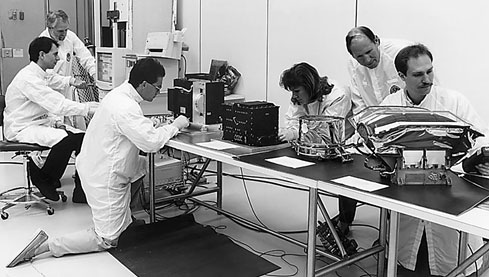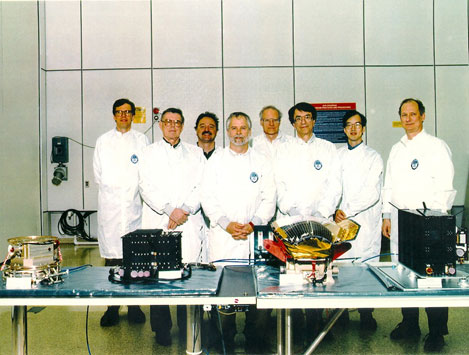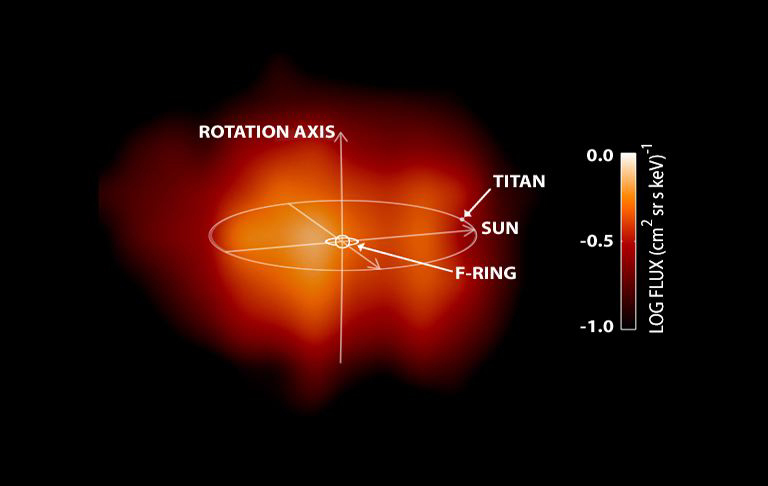Press Release
After a Mission of Amazing Science, APL Bids Farewell to Cassini
Fri, 09/15/2017 - 15:22
This morning, after two decades in space, NASA’s Cassini spacecraft ended an incredible journey of exploration. With the spacecraft’s fuel spent, operators deliberately plunged Cassini into Saturn — which it has orbited for 13 years — to make sure the planet’s moons remain pristine for future exploration.
With Cassini on its fiery descent went a small but significant piece of APL — the Magnetospheric Imaging Instrument, or MIMI. In the early 1990s APL partnered with six other institutions to design and build MIMI, which studied the local environment of charged particles trapped in Saturn’s magnetosphere and also made global images of fast neutral atoms.
APL built one of MIMI’s three sensors — the Ion and Neutral Camera (INCA) — which produced the first-ever images of a planet’s magnetosphere using an APL-developed technique known as energetic neutral atom (ENA) imaging. “Over the past few years, the ENA technique has become a standard part of current and planned payloads for planetary magnetospheres and the heliosphere,” said Tom Krimigis, the head emeritus of APL’s Space Exploration Sector who served as MIMI principal investigator until 2015. “MIMI/INCA has been a key innovation in plasma instrumentation that will benefit space science research for years to come.”
Before INCA, spacecraft obtained what is known as fields-and-particles data from its local surroundings — the area in which the spacecraft was then operating. But INCA, essentially a pinhole camera, makes images out of fast neutral atoms instead of photons. With this technique, instruments were no longer restricted to the local environment of the spacecraft, but instead could produce global images that illuminate the structure and dynamics of different aspects of the entire magnetospheric system.
“The capability of ‘seeing’ the global magnetosphere and creating movies of its dynamics was a brand new capability at any planet other than Earth, and has led to many insights and discoveries that would have been either impossible, or only accomplished through inference without the INCA ENA imager,” said current MIMI Principal Investigator Don Mitchell, of the Space Exploration Sector (SES). “The science community will be analyzing these observations for many years.”

Credit: APL
Great Data Creates Great Research
Plenty of scientific analysis has already occurred since Cassini arrived at Saturn in 2004. According to MIMI Deputy Principal Investigator Chris Paranicas, of SES, more than 175 refereed journal articles and book chapters have been published by MIMI team lead authors, with hundreds of others that use MIMI data and include MIMI team co-authors. Careers have also been built, he added, with at least 14 doctorates earned using (mostly) MIMI data.
“I started my scientific career by doing my Ph.D. thesis using Cassini data, and I’ve worked with it since then,” said Peter Kollmann, also of SES. “Because of this, I look at every new topic with my ‘Cassini eyes.’ I find the amount and wide range of science it covered during its lifetime is amazing.”
Mitchell proudly checks off several scientific discoveries coming from MIMI and INCA, such as characterizing the radiation environment of the whole Saturnian system, measuring particles that power auroral signatures in various ways, and those that modify the surfaces of satellites and rings. INCA boosted understanding of global dynamics, including large-scale disruptions of the system and periodic phenomena. Its charged-particle measurements were central in identifying a noon-to-midnight planetary electric field whose origin is not known, in revealing ring arcs that were not imaged, and in linking solar wind perturbations to system changes. INCA also imaged Jupiter on Cassini’s path to Saturn, beginning in 2000, from more than half an astronomical unit (about 50 million miles) away.
The instrument was also key to discovering an electrical current running between Saturn and its icy moon Enceladus that creates an observable “footprint” on the ringed planet — a finding that helped scientists connect the planetary latitude and satellite distance. Importantly, it also looked beyond the Saturn system, helping to redraw the shape of our solar system by gathering data that suggested our heliosphere — the area of the sun’s influence that surrounds the solar system — may not have the comet-like shape predicted by existing models.
Engineering Innovations
To get all of that data, Mitchell recalled, the team made some clever moves in building, testing and calibrating MIMI leading up to Cassini’s October 1997 launch. Lacking the vacuum drive motors capable of handling the actual torques that would be imposed on the INCA sensor in space, then-intern (and current SES staff member) Sanae Kubota helped to design a Rube Goldberg-like system with pulleys and counterweights to relieve the actual drive motors of high torques. “It looked funky, but it worked,” Mitchell said.
Looking for an extra layer of dust protection for the sensor’s sensitive components, the team put double-sided Kapton tape inside the launch aperture acoustic cover, like flypaper, to catch any small particles that might be trapped in the small space between the cover and the very thin entrance foil just a couple of millimeters away.
Engineers also devised a way to evenly distribute forces by securing the electrostatic plates around MIMI with Kevlar cord — something that hadn’t been done before. “Don Mitchell and Tom Krimigis were very supportive of the groundbreaking design work we were doing and fostered a culture of independent thought and innovation and support,” said Steve Vernon, the instrument’s mechanical design engineer from SES.
That type of interaction was common on what ground-system software engineer Martha Kusterer describes as a close-knit and responsive team. “We had issues come up and we always knew who to call, they answered and the issue was resolved,” she said. “I remember one instrument activity occurred during an ice storm and some of us had to stay at the Lab overnight. But you do what you have to. I feel a great sense of accomplishment and a little sadness to think about the end of the mission, but what a great mission!”

Credit: APL
Discoveries Abound
MIMI wasn’t the only vehicle for APL scientists to make discoveries during the Cassini mission.
For example, Mark Perry was part of a team that found hydrogen gas — which could potentially provide a chemical energy source for life — pouring into Enceladus’ subsurface ocean from hydrothermal vents on the sea floor. The presence of ample hydrogen in the icy moon’s ocean means that microbes, if any exist there, could use it to obtain energy. “This is the first time that we have found so many of the essential components for life in one place beyond our own planet. And it is one of the least expected places, too: a small moon far from the sun,” Perry said. “This remarkable discovery gives us great hope that we will eventually find life somewhere besides Earth.”
Ralph Lorenz, one of the world’s leading experts on Saturn’s largest moon, Titan, has worked on Cassini for his entire 27-year career. His first book, “Lifting Titan’s Veil” in 2002, covered what we knew before exploration by Cassini and its Huygens probe, which landed on Titan in January 2005. In 2010 he wrote about what the mission found in “Titan Unveiled,” and this year captured what he described as “all the nerdy details of the spacecraft development and operation” in the “Cassini-Huygens Owners Workshop Manual.”
Icy moons expert Zibi Turtle led a team that mapped Titan’s surface in the near-infrared and followed its weather patterns as they changed with the seasons over 13.5 years of Cassini observations. On two occasions, they discovered that clouds had produced extensive methane rainfall, once at the south pole during Titan’s late southern summer and later in the equatorial deserts during northern spring — the first time scientists obtained current evidence of rain soaking Titan’s surface at low latitudes. “It’s amazing to watch such familiar activity as rain and seasonal changes on a distant, icy satellite,” she said.
And APL supplied the ultrastable oscillator that provided a frequency reference to the spacecraft’s communications transponder, and was a vital component of the radio science subsystem. Cassini’s radio science measurements produced detailed information about the structure of Saturn’s rings and atmosphere, as well as the atmosphere of Titan.
A Part of APL
“I feel sad in a way that Cassini and MIMI have to end in this fashion, but I understand the necessity to do so,” said Ray Thompson, who served as the instrument’s principal technician. “This will be the second instrument that I worked on to go into a neighboring planet, the first being the [APL-built] Galileo Energetic Particle Detector, into Jupiter [in 2003]. I feel like a part of me goes with it.”
And this morning, dozens of current and former APL staff members felt the same way.
The Cassini-Huygens mission is a cooperative project of NASA, the European Space Agency and the Italian Space Agency. JPL, a division of the California Institute of Technology in Pasadena, manages the Cassini-Huygens mission for NASA’s Science Mission Directorate, Washington. The Cassini orbiter was designed, developed and assembled at JPL. Learn more about the Cassini mission and its Grand Finale at https://saturn.jpl.nasa.gov/.
